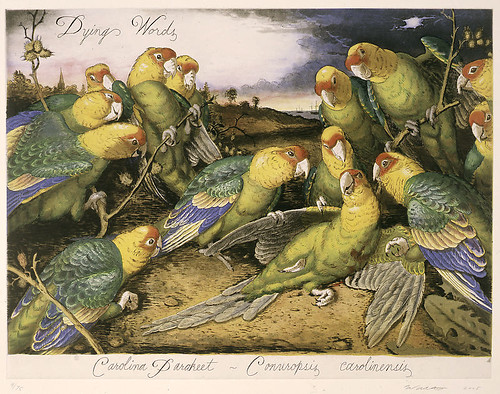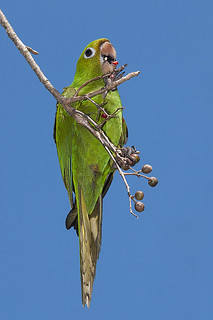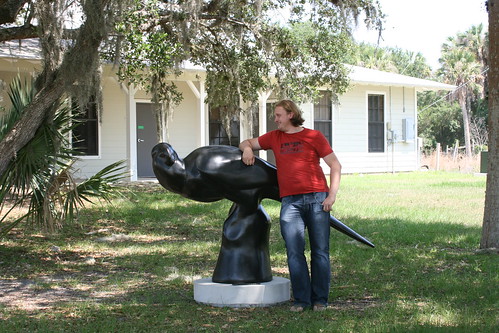 Walton Ford's unsurpassed impression of the Carolina parakeetIt is likely that in historic and prehistoric time the Carolina parakeets interbred with close relatives in Mexico and the Caribbean. The genes that made Carolina parakeets unique could still linger in these populations. With the advances in Molecular biological techniques identifying those genes is now possible. Screening the conure populations of Mexico and the Caribbean could identify specimens with genes of the lost Carolina parakeet. Bringing such birds together trough selective breeding should result in birds that much resemble Carolina parakeets genetically. Genes that can’t be found could be synthesised. Ultimately resulting in the deextinction of the Carolina parakeet.
Walton Ford's unsurpassed impression of the Carolina parakeetIt is likely that in historic and prehistoric time the Carolina parakeets interbred with close relatives in Mexico and the Caribbean. The genes that made Carolina parakeets unique could still linger in these populations. With the advances in Molecular biological techniques identifying those genes is now possible. Screening the conure populations of Mexico and the Caribbean could identify specimens with genes of the lost Carolina parakeet. Bringing such birds together trough selective breeding should result in birds that much resemble Carolina parakeets genetically. Genes that can’t be found could be synthesised. Ultimately resulting in the deextinction of the Carolina parakeet.
Introduction
To breed Carolina parakeets (Conuropsis carolinensis) you need a balanced diet, a good size flight, some branches and other enrichments for them to chew on, a little peace and quiet and a nice nest box. But more importantly however you need a boy and a girl Carolina parakeet.
 Juvenile Carolina parakeets (centre) were green. Simular to other Psittacara parakeet juveniles.On March 15, 2013 the TEDxDeExtinction event was held at the Grosvenor Auditorium in Washington, DC. The event sparked a lot of discussion in avicultural circles. Up to 20 parrot species have gone extinct since 1500 AD. Some are obscure footnotes of history. Others speak vividly to us from the works by observers of the time. Non probably more so then the Carolina parakeet.
Juvenile Carolina parakeets (centre) were green. Simular to other Psittacara parakeet juveniles.On March 15, 2013 the TEDxDeExtinction event was held at the Grosvenor Auditorium in Washington, DC. The event sparked a lot of discussion in avicultural circles. Up to 20 parrot species have gone extinct since 1500 AD. Some are obscure footnotes of history. Others speak vividly to us from the works by observers of the time. Non probably more so then the Carolina parakeet.
The Carolina parakeet was both unique and familiar. The quintessential conure we have come to know in many forms and shapes but uniquely distributed in North America where no other parrots reached. Its loss has been an exemplary failure of both conservation and aviculture as this parakeet was bred in captivity several times and even had a short lived introduced population in Germany.
The TEDx event showed us that we can now contemplate bringing back species from extinction. Here I explore ways for aviculture to become part of this effort and perhaps mend a wrong that has been done to this species.
Deextinction for beginners
 The Hispaniolan Parakeets under certain light conditions show a lot of yellow on their heads. Aviculture has tried to reproduce extinct species before. From the 1950’s onwards Golden shouldered parakeets were crossed with Mulga parrots to create a parakeet that looks similar to the, now presumed extinct, paradise parrot (Psephotus pulcherrimus). Sometimes for nefarious purposes.
The Hispaniolan Parakeets under certain light conditions show a lot of yellow on their heads. Aviculture has tried to reproduce extinct species before. From the 1950’s onwards Golden shouldered parakeets were crossed with Mulga parrots to create a parakeet that looks similar to the, now presumed extinct, paradise parrot (Psephotus pulcherrimus). Sometimes for nefarious purposes.
Its been suggested that hybrids of Janday and Red-masked parakeets look very similar to Carolina parakeets (I would be grateful if anyone could provide a picture of such a hybrid). Hybrids however do not fool anyone. Nonetheless the idea of combining extant bloodlines to recreated extinct ones remains intriguing.
The Quagga project
In 1987 the Quagga project commenced. Research had shown the extinct Quagga (Equus quagga quagga) to be a subspecies of the extant Plains Zebra (Equus Quagga). Founder of the quagga project - Reinhold Rau - figured that the traits that made Quagga unique must still be present in other populations of Plains Zebra with which Quagga interbred. In 1987 he started selecting Plain Zebras that exhibited less striping on their hindquarters and legs. These where brought together for selective breeding purposes. Now in 2013 some of these Plains Zebras look much like the Quagga that the project was aiming for. Even more remarkable is that these animals now live freely on reserves in the former range of the Quagga. There is still work to be done but the Quagga project has shown one possible road to travel.
Hybrid zones
Similar to the Quagga and its Plain zebra neighbours, conure hybrids are usually fertile. For the Carolina parakeet this makes hybrid zones with its geographically psittacine neighbours a possibility. A recent study however shows that the Green, Cuban and Hispaniola parakeets are perhaps more distantly related then previously assumed. Further research is needed to confirm Carolina parakeets closest relatives.
 Many specimens of Green parakeets (Psittacara holochlorus (previous in Aratinga)) populations in Texas show remarcable patches of both orange/red and yellow on the heads and torso that are less prevelent in Mexican populations. Image by Jerry Oldenettel.Whatever the precise relationship of the Carolina parakeet was with the other conures, Green parakeets (Psittacara holochlora) presently reach right up to the southern most known range of the Carolina parakeet: Corpus Cristi, Texas. The Green parakeets of Corpus Cristi however are most probably introduced to the city. What is remarkable however is that the Southern Texas populations of Green parakeets exhibit quite a bit of yellow with the red feathers on their heads in contrast to Mexican populations that usually exhibits only red specs on their green heads. The red and yellow colouration on the head is typical for the Carolina parakeet.
Many specimens of Green parakeets (Psittacara holochlorus (previous in Aratinga)) populations in Texas show remarcable patches of both orange/red and yellow on the heads and torso that are less prevelent in Mexican populations. Image by Jerry Oldenettel.Whatever the precise relationship of the Carolina parakeet was with the other conures, Green parakeets (Psittacara holochlora) presently reach right up to the southern most known range of the Carolina parakeet: Corpus Cristi, Texas. The Green parakeets of Corpus Cristi however are most probably introduced to the city. What is remarkable however is that the Southern Texas populations of Green parakeets exhibit quite a bit of yellow with the red feathers on their heads in contrast to Mexican populations that usually exhibits only red specs on their green heads. The red and yellow colouration on the head is typical for the Carolina parakeet.
Modern genetic techniques
When we selectively breed conures to look more like Carolina parakeets are we looking at phenotypic similarities that are only skin (plumage?) deep or are we really progressing towards the species we like to see again? The avicultural efforts to reproduce the paradise parakeet or the project to rebreed the Quagga seem crude in today’s age of DNA analysis. Instead of relaying on appearances shouldn’t we look for the actual genes that characterized a species?
 Philadelphia academy of natural sciences collection of Carolina parakeet specimens. Image by Billtacular
Philadelphia academy of natural sciences collection of Carolina parakeet specimens. Image by Billtacular
Modern molecular biology now has the tools to sequence the complete genome of extinct species using DNA obtained from museum specimens, revealing the code that nature uses to build a species. With that code we could identify the key variances that made the Carolina parakeet different from their close relatives. The actual set of genes you need to find and combine to produce the Carolina parakeet.
Those genes, once identified, can be brought together in a chip (micro array chip/ SNP array) that functions as a genetic test. Similar tests have been used to screen women for breast cancer genes. Such a chip can be applied to sample individuals from related conures in hybrid zones (northern mexico, Texas, Cuba, Hispaniola) to see if they carry Carolina parakeet genes. Birds carrying genes of interest could be brought together to breed to combine those genes trough selective breeding. Building a population progressing towards the genome of the Carolina parakeet. Every generation could be tested with the same method. Those birds that progressed the most should be selected to produce the next generation.
Missing genes
Chances are that this enhanced selective breeding technique will not be enough to reach the exact genome of the Carolina parakeet. With enough generations the birds will no doubt look much like Carolina parakeets but are they? It is normal for individuals to differ from each other genetically but when are these differences too big to be considered the same species? One solution is to see what the total gene variance of the Caroline parakeets museum specimens is. This calls for much sequencing, but gives insight into the Carolina parakeets’ natural genetic diversity. With that we could then derive a statistical measure that we can allow the neo-Carolina parakeets to deviate from.
If this is unsatisfactory we could also order the missing genes from the lab, a promising technique that is presently being developed. This will however take the de-extinction of the Carolina parakeet out off the hands of aviculture and into the lab. But the birds that aviculture produced trough the enhanced selective breeding possess are the perfect genetic scaffolding to incorporate the missing genes, reducing lab work to a minimum.
Another option is to wait for spontaneous mutations to occur. Aviculture has proofed to be proficient at breeding mutations. Again these involve visual variance specifically colour mutations like the inevitable blue, lutino and albino colour morphs that show up in captive parrot populations. With the aforementioned chip successive generations could also be screened for the needed mutations to happen.
 Carolina Parakeet Monument at the Kissimmee prairie preserve state park
Carolina Parakeet Monument at the Kissimmee prairie preserve state park
When can we start?
Apparently some breeders in Florida have already started cross-breeding different conures to create something similar-looking to the Carolina parakeet. Their results however are shrouded in mystery. Howerd Voren has released a picture on facebook of his efforts to recreate that other extinct Neotropical psittacine the Cuban macaw. These efforts are interesting and worthwhile and I hope people will share more about their plans and progress. Getting the genetics right is however vital for such endeavours to be regarded a true success. Therefore we must start with getting the complete genome of the Carolina parakeet sequenced. According to the lab that sequenced the Carolina parakeets’ mitochondrial COI and ND2 genes, such efforts would cost about $150.000 USD. That would just be a start and to finalise this project we will have to multiply that sum perhaps 10 times. Parakeets looking like Carolina parakeets might already be present in aviculture. Nevertheless it will take many generations and clever molecular biologists before the Carolina parakeet will fly again. But I am confident I will witness their return to the eastern United States.